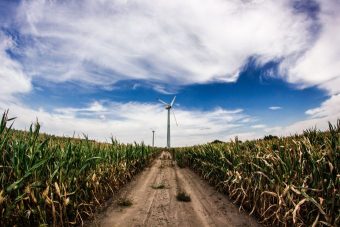
The Republic of Ireland is hoping that a new wind farm in the west of Ireland will help it meet its international climate change targets.
It is understood there will be 69 turbines located on the new Wind Park site in Connemara in County Galway.
Spreading over 40 sq km, the project is expected to generate about 3% of the country’s needs.
The Galway Wind Park is a joint venture between energy provider SSE and the Irish state forest company Coillte.
Connemara is home to the biggest wind farm in Ireland and is founded on part-bog land, which is more associated with another and much older fuel – peat.
While peat may give off a pleasant aroma when burning and add a distinctive flavour to whiskey it is a dirty fuel that emits 23% more carbon dioxide than coal.
Clean and green wind farms are modern and very different, according to John O’Sullivan from SSE.
“When you contrast wind with peat the biggest factor is carbon,” he said.
“Peat would release a lot of carbon when burned, while wind, of course, is carbon neutral,” he said.
The firms behind the project say a lot of effort has gone into minimising the visual impact on the landscape and keeping the local community on board.
Although there will be just under 70 turbines, even in a blustery location wind is unpredictable.
Too little and no energy, too much and the excess power will have to be exported via an inter-connector because wind energy cannot be stored at the moment.
James O’Hara, the project manager, said: “On completion the Galway Wind Park will be Ireland’s largest wind farm with a capacity for 169MW of power.
“That will be enough energy to power 89,000 homes, which is about 80% of Galway’s homes.”
Solar panels are also being installed on 2,500 acres of other bog land in four counties in the Irish Midlands – another example of old energy forms being replaced by and new ones.
Pat O’Doherty, the chief executive of the Electricity Supply Board, recently said that keeping local communities happy with the new projects is very important.
“We’re talking about remote locations that are tucked away and low-lying,” he added.
“You’re looking at something that isn’t more than 2m off the ground and, obviously, facing towards the sky.”
Denis Naughten, the Irish minister with responsibility for climate change and the environment, agrees.
“I think we have really learnt a lot from what has gone on in relation to the on-shore wind industry,” he said.
“There needs to be a proper and full engagement with local communities and there needs to be a clear economic benefit to those communities as well.”
Back in Connemara, those involved in the Galway Wind Park say they have fully engaged with local people.
The project is expected to be officially completed at the end of September.
Source: bbc.com

